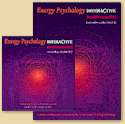![]() The Energy Medicine Handout Bank
The Energy Medicine Handout Bank ![]() About the Bank Featured Articles Latest Articles All Articles
About the Bank Featured Articles Latest Articles All Articles ![]()
Energy Medicine
Case Histories
Innersource
![]()
Health Q & A’s
from an
Energy Medicine
Perspective
![]()
View Free Issues
Energy Community Report
![]()
Download the First
Energy Medicine
Newsletter
![]()
 Energy Medicine Books & Videos
Energy Medicine Books & Videos
Innersource ![]()
Energy Medicine
Foundation Classes
Innersource
Program Details
![]()
Energy Medicine
Certification Program
Innersource
![]()
Energy Medicine
Practitioners
Innersource
![]()
Other Energy
Medicine Resources
Energy Medicine Directory
![]()
Energy Psychology
An Exciting New
Specialty within
Energy Medicine
 Energy Psychology
Energy Psychology
Books & Videos ![]()
EMI Activities
in Behalf of
Energy Psychology
![]()
Energy Medicine
A Career
for the Future
![]()
Contribute
to The Energy Medicine Institute
Energy Psychology Case Histories with Two Veterans with PTSD ![]()
The Vets Stress Project (http://www.stressproject.org) has made Energy Psychology available to hundreds of veterans and has spawned several research studies which demonstrate the speed, effectiveness, and durability of the approach. One of the therapists involved in this project is Ingrid Dinter. She provided the following two case histories. Additional case histories can be found on the Vets Stress Project website (above).
Case 1:
![]()
“Keith” was an infantry soldier for the Ninth Division in the Mekong Delta during the Vietnam War. During an initial session in April 2008, he reported that he had seen “many casualties on both sides” and was “still tormented with nightmares and repeated flashbacks . . . sometimes I think I see Viet Cong soldiers behind bushes and trees.” His severe insomnia, complicated by the nightmares, kept him fatigued and low functioning (self-rated as a 2 on a scale of 1 to 5) during the day. He had been diagnosed with PTSD and reported having “had group and individual therapy through the VA with little results.” He was also diagnosed with Parkinsons disease and was on multiple medications for Parkinsons, PTSD, insomnia, and depression, though they were affording little or no relief for his psychological symptoms.
Just prior to treatment, Keith completed the PCL-M, which is the military version of the PTSD Checklist (Weathers, Litz, Herman, Huska, & Keane, 1993). His score was 65. The PTSD range is 50 or above.
Keith received six sessions that combined tapping on acupoints with the mental activation of traumatic war memories and other psychological stressors. The treatments averaged about an hour each, with the first five occurring within the initial week and a follow-up session about two months later. The second session focused on Keiths profound sadness and guilt for shooting off another man’s arm from close range while the man was probably trying to surrender. By the end of the tapping protocol, Keith was able to recall the horror of the situation with no self-reported physiological reaction. This made it possible for him to fully embrace his sadness about what he had done, recognize that it was in the context of war and it was possible that the man was not surrendering, and to ask his own internal representation of the victim for forgiveness. Following that session, Keith sent an e-mail: “Sleep is improving, no nightmares last night. My overall energy has been on an upswing. My hands still shake but not as much. I’ve been tapping on the shakes and it seems to help. I think what we’ve worked on is quite amazing.” The third session focused on Keith’s anguish and self-blame about the death of his closest friend. Even though Keith received a bronze star for his efforts to save his friend, he felt he did not deserve it since his friend did not survive and he still wept about the loss. Again, by the end of the tapping, Keith was able to access the memory without physiological distress. Following this session, he reported continued sleep improvement and feeling “much more at ease.” Subsequent sessions focused on additional combat traumas as well as incidents from his childhood and the general stress and tension in his life.
From the end of the war until he began treatment, Keith was rarely able to get more than one to two hours of sleep at a stretch, and he reported averaging about two nightmares each night. By the end of the fifth session, he was getting seven to eight hours of sleep each night and was having no nightmares. He reported at the two-month follow-up session that the improved sleep patterns remained stable and symptoms such as intrusive memories, startle reactions, and overwhelming obsessive guilt had abated. At the end of the fifth session, Keith’s PCL-M score was down from 65 to 34 (the PTSD cutoff is 50). Three months later the score had stayed stable at 34 and six months later it was 32.
Case 2:
![]()
A U.S. Coast Guard veteran who had served as the only female in an elite search and rescue unit had been on medical disability since 1993 for both psychiatric causes (PTSD) and physical conditions (spinal injury and tendonitis). She had frequently been in life-threatening situations during non-combat rescue operations and had also suffered severe sexual assaults while in the military. She scored 76 on the military version of the standardized PTSD Checklist (scores above 49 exceed the PTSD cutoff) administered immediately before commencing exposure/acupoint treatments in April of 2008. Severe sleep disorder was a pervasive underlying symptom. Previous treatment included years of individual and group counseling at the Veterans Administration, psychiatric medications, a course of in-patient treatment as a result of high suicidality/homocidality, PTSD Awareness Training, a program at the University of New Mexico that focused on reducing nightmares in PTSD patients, and a variety of auxiliary approaches such as Transcendental Meditation and nutritional counseling. None provided significant or sustained symptom reduction.
Treatment consisted of four 90-minute telephone sessions using an exposure/acupoint approach known as EFT (“The Emotional Freedom Techniques”) administered over a 10-day period. One month after the final session, the PTSD Checklist scores had dropped from 72 to 47, falling below the PTSD cutoff, and the sleep disorder symptoms had resolved. At that time, the patient provided a written narrative, commenting that after all her previous treatments: “I still couldnt fall asleep. I couldnt remain asleep without waking up repeatedly during the night. And I was plagued by repeated traumatic nightmares every night. Sleep was my enemy, and I fought it every night, waking up exhausted and tired . . . Within two sessions [of EFT], I felt myself release all the associated trauma, emotions, and obsessions that interfered with my sleep. Sleep became an easy and gentle activity free from worry and fretting. . . . No more nightmares.” One-year post-treatment, she reported having self-applied the tapping protocol almost daily and her PTSD Checklist score was down to 32.
![]()
One of EMI’s major projects is to bring national attention and resources to Energy Psychology. Learn more about Energy Psychology and EMI’s efforts:
![]()
Background
![]() Energy Psychology Fact Sheet Energy Psychology Case Histories with Two Veterans with PTSD A Video Clip Showing Before Treatment and Post-Treatment Interviews with Four Veterans An Academic Paper on How Energy Psychology Works Summaries of 9 Academic Papers on Energy Psychology Assessing Energy Psychology Courses According to APA CE Criteria Energy Psychology in the News
Energy Psychology Fact Sheet Energy Psychology Case Histories with Two Veterans with PTSD A Video Clip Showing Before Treatment and Post-Treatment Interviews with Four Veterans An Academic Paper on How Energy Psychology Works Summaries of 9 Academic Papers on Energy Psychology Assessing Energy Psychology Courses According to APA CE Criteria Energy Psychology in the News
for Veterans and Other Trauma Survivors
Home Handout Bank Energy Medicine Q & A’s Energy Community Report
Contribute to the Energy Medicine Institute Energy Psychology
The Energy Medicine Institute
777 East Main Street – Ashland, OR 97520
(541) 482-1800
* ]]> *
www.energymed.org
Design, Development, Hosting, and Maintenance by The CyberSide & Co.
All contents copyright © The Energy Medicine Institute, 2001-2017. All rights reserved.


